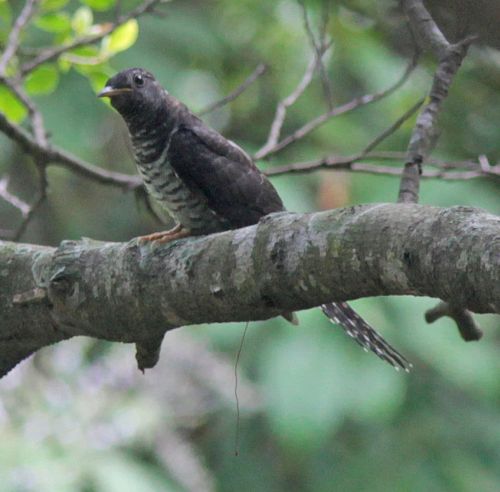I said the spiders on Po Toi are bigger than ever but I never thought they could catch and kill a bird as large as an Asian Brown Flycatcher (see the previous report by Herman). I’ll be more careful in future.
This is nature. Spiders are not as cute and cuddly as an Asian Brown Flycatcher but they have the same right to life. It shows the dangers faced by migrating (and resident) birds, and why only one in three survives the first year of life.
Only a few photos from me this week, I seem to have lost the snapping urge. But I did get the big one – the Lesser Cuckoo. This is a difficult bird, not seen by anyone on either Tuesday or Thursday (bad luck for the day-trippers) but I had it for 10 minutes at 11am on Wednesday around the toilet block.


There are four previously accepted HK records for Lesser Cuckoo, all juvenile (first-year) birds in September/October although Mike Kilburn has reported what must be an adult bird in May this year. The species mostly winters in East Africa so it’s a really long-distance migrant.
Also on my list this week, Yellow Bittern, Grey Nightjar, several Dollarbirds, Forest Wagtail, Brown Shrike, Oriental Reed Warbler, at least six Asian Brown, one Dark-sided and two Yellow-rumped Flycatchers and a single White-shouldered Starling. I disturbed the Grey Nightjar taking a nap on a gravesite and got views down to one metre – not for long though.
Bright-capped Cisticola are already back on the South Peninsular. I shall be surprised if they don’t nest there or at the top of the nearby hills.
Autumn Brown Shrikes on Po Toi are mostly the race
cristatus, very different to the grey-headed
lucionensis of spring, as you can just about see from this long-distance photo of one on Thursday.

This is another example of the rule – Philippine winterers in spring, SE Asian winterers in autumn.
Migrants seen in the early morning flying over or off the South Point during the week were Pond Heron, Barn Swallow, Yellow and Grey Wagtails, Tree Sparrow and Black Drongo – a fairly typical assortment for early autumn. Also the only seabird, a single adult Aleutian Tern which flew SW very fast on Wednesday morning, as though it was trying to catch up with others – maybe I’ve missed the main migration this year.
I got it wrong about a team demolishing the School (last week’s report). Actually they are doing ‘slope maintenance’, which probably means even more concrete over the ever-decreasing space for trees. But I have faith in nature reclaiming what really belongs to it, not the Lands Department.
[
Last edited by wgeoff at 9/09/2011 05:44 ]


